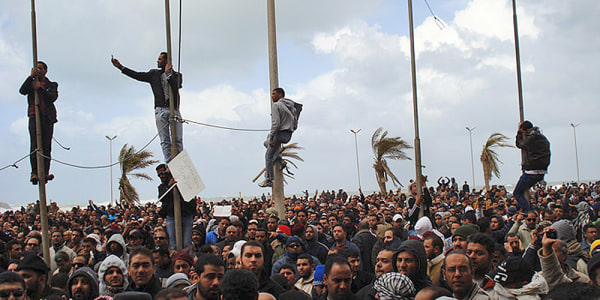When he sees reports from Libya of a euphoric youth rebellion crushed in a brutal armed crackdown by an Arab ruler, Ahmed al-Saidi is overcome with an ominous sense of deja vu.
A survivor of the failed 1991 uprising against Iraq's Saddam Hussein, Saidi knows what it feels like to believe the international community will help you overthrow a dictator, only to find your town abandoned to merciless revenge.
"Of all the news from other Arab countries, Libya is the one that is most moving for me. It is as if it was copied and pasted from Iraq," he says.
"Almost the same atrocities that happened in Iraq are happening in Libya. The same shy response from the international community. The same shameful hesitance from the Arab world."
"God willing, the rebels in Libya will still succeed. But I fear the casualties will be huge."
In 1991, Saidi was a student at Baghdad University, sheltering from the Gulf War in his home town near the city of Nassiriya 180 miles from Baghdad in the mainly Shiite south, when the wind of revolution blew through Iraq.
Iraqi troops, once seen as invincible, were returning in disgrace from a humiliating defeat at the hands of a U.S.-led coalition after Saddam's invasion of Kuwait.
Nassiriya was buzzing with news that in Basra, heartland of the south, a returning soldier had fired a tank shell at a portrait of Saddam. U.S. President George H.W. Bush was encouraging Iraqis to rise up and overthrow the dictator. The unthinkable suddenly seemed possible.
Word spread among the city's youth to converge on the headquarters Saddam's Baath Party. Crowds poured into the streets. Security forces and protesters clashed with rifles and rocket-propelled grenades.
Saidi dragged away the body of a close friend shot dead before his eyes. But his sorrow was followed by the taste of victory. Within an hour, government buildings were overrun and the rebels were in control of the city.
Saddam's revenge was swift and brutal. The next day lorries and armored vehicles carried a brigade of Saddam's elite guards into the town, firing at random. The streets emptied.
Saidi, who had torn up the portrait of Saddam that hung on his family's wall, quickly burned the scraps in the mud-brick bread oven to destroy the evidence.
Soldiers banged on the door with rifle-butts and ordered people to leave their homes and gather in an open area in the desert. Thousands walked on foot to the staging ground, where young men were herded into waiting trucks and driven off.
Nasir. Ali. Saidi calmly recalls the names of his childhood friends who were driven off that day, never to be seen again.
'Failed' chance
He and a nephew managed to escape, hiding in the tall grass of a garden. They made their way on foot to a village 22 miles away and hid for a month, finally returning when family sent word that the coast was clear and the arrests had stopped.
"I realized the international community was not going to help ... We had had our chance and we had failed."
Saidi returned to his studies in Baghdad, although later that year during a visit to the south he was detained, held for a week in a small room with 30 other men and one toilet, kept awake through the night by the sound of torture.
The international community imposed no-fly zones on southern and northern Iraq. The northern no-fly zone probably helped Kurds there win de-facto independence that continues in the form of autonomy today. But the southern one was too little, too late and did nothing to shield the people from Saddam's wrath.
Today, foreign powers are considering a no-fly zone for Libya. Saidi fears that history is repeating itself.
Slideshow 81 photos
Libya's uprising against Gadhafi
"The no-fly zone happened in Iraq when it was too late, when the uprising was already finished. With this no-fly zone in Libya, I fear the same thing, that it is too late. They should have started it before [Moammar] Gadhafi began recapturing territory."
Twelve years after the failed uprising, U.S. troops returned under Bush's son and finally removed Saddam from power. Today, Saidi works as a freelance journalist.
His profession, he says, is the one factor that distinguishes Libya now from the Iraq of two decades ago.
"There is only one difference. At least there is media now in Libya telling the world what is happening. In 1991, there was no media in Iraq. Nobody knew."
Additional reporting by Waleed Ibrahim.
